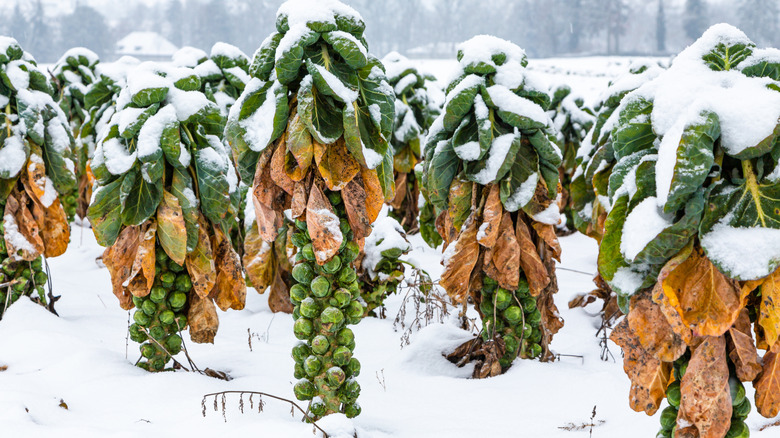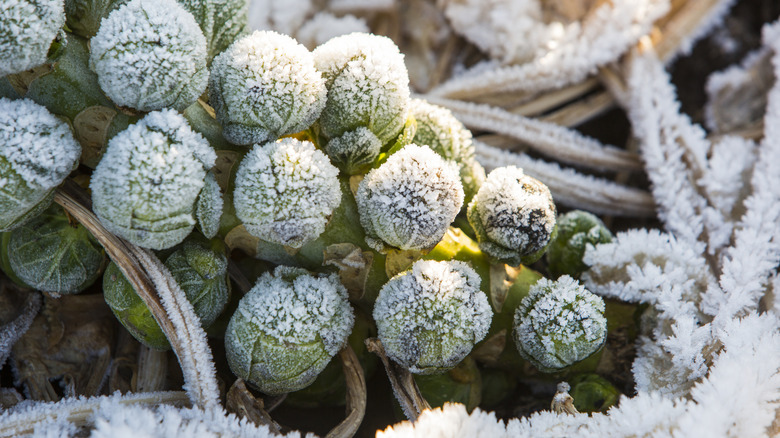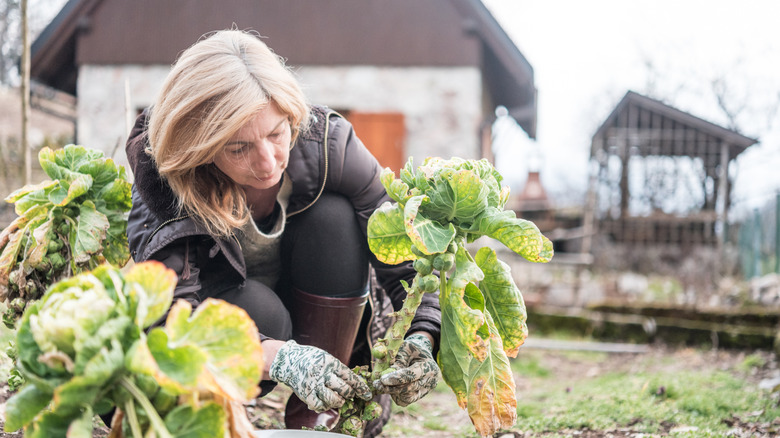Why Late Winter Might Be The Best Time To Harvest Your Brussels Sprouts
Cold-weather vegetable crops, like Brussels sprouts (Brassica oleracea), extend your growing season and ultimately ensure you get the most out of your garden. But did you know that you might be able to extend Brussels sprout season even further? For most gardeners, these cold-hardy vegetables are harvested in the fall, but depending on where you live, you may want to wait. For instance, if you live in a place with mild but cool winters, such as USDA Zone 8, a bit of patience will result in better sprouts.
When it comes to growing Brussels sprouts, frost is your friend. Exposing your plants to a couple of frosts late in the season will help your plant convert the starches that often taste bitter into sweeter sugars. The result is delicious sprouts that taste much better, and fresh produce well into the deeper months of winter. It may even be possible to overwinter Brussels sprout plants in colder climates with a little extra work.
Growing Brussels sprouts through winter
If you live in a place with milder winters, you may want to wait until as late as March to harvest to get the best-tasting sprouts possible. In fact, you may be able harvest all winter long (more on the harvesting process later). However, if you live in an area with prolonged periods of sub-freezing temperatures, the cold will eventually kill your plants unless you put in some extra work — though those first couple of frosts in the late fall will help your plants develop flavor as well.
If your area experiences a hard freeze but you still want to experiment with overwintering your Brussels sprouts, there may be hope. Use a deep layer of mulch to keep your plants a bit warmer, and protect them with burlap or cardboard before a hard freeze to help your plants make it through the winter. If this is the first time you've tried this, we recommend planting a few extra plants to experiment with and acquainting yourself with ways to protect your vegetable garden from freezing temperatures.
Tips for growing and harvesting the best Brussels sprouts
For the best results, plant your Brussels sprouts in well-drained soil without excessive nitrogen, and water them regularly, as brassicas don't mind having wet leaves. Exposure to heat causes Brussels sprouts to bolt, so these plants are typically planted in the garden much later (or earlier) than warm-weather crops. To harvest them in fall, keep in mind that depending on the variety, they will typically need between 80 and 100 days to mature, and plan accordingly. However, the sprouts will not all be ripe for the picking at the same time, so you will want to harvest strategically.
Harvesting in stages will ensure you are getting each sprout at the right time. Starting from the bottom up, look for sprouts that are firm, bright green, still closed, and about 1 to 1.5 inches in size. Also, consider pinching off the top of your plants about a month prior to your first frost to shift the plant's focus to maturing sprouts. If you follow these tips, it should be easy to know exactly when to harvest your sprouts for the best flavor, regardless of what month it is. And remember, Brussels sprouts are just one of many vegetables to harvest after a frost, so there are plenty of ways to continue extending your growing season.


